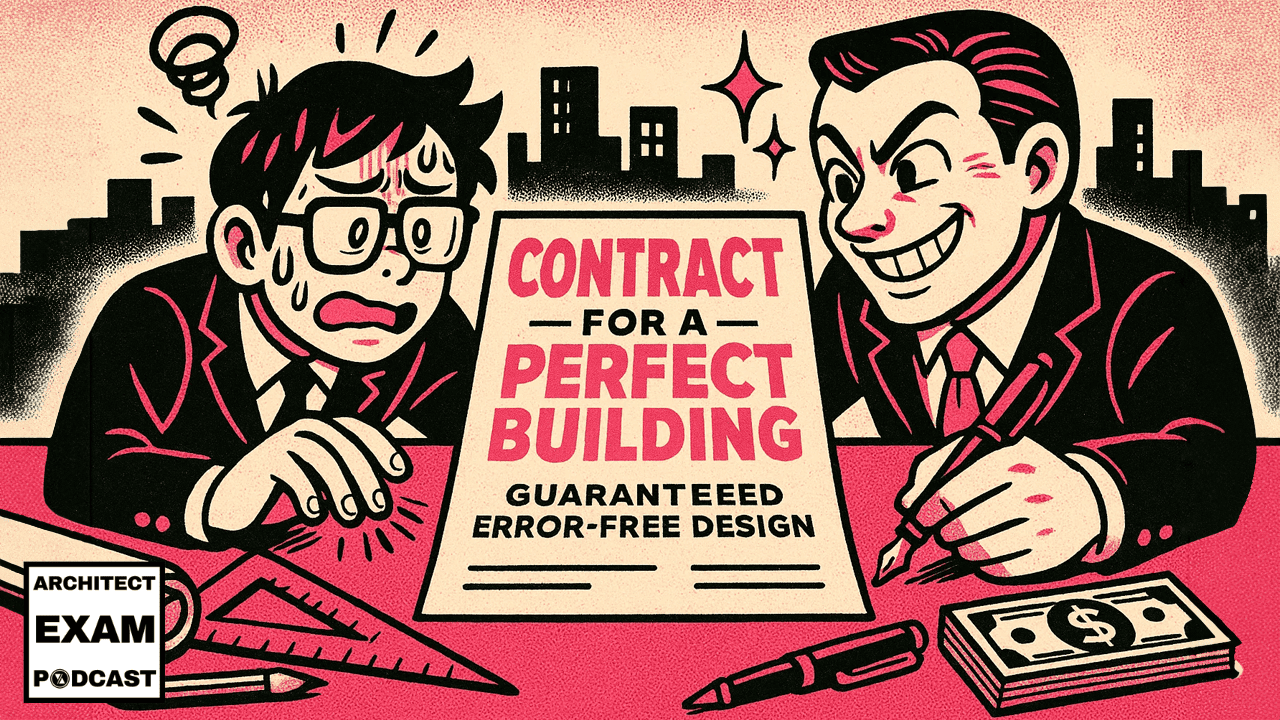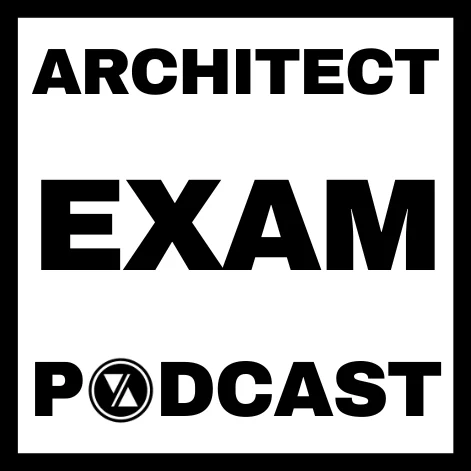The concept of an Architect’s Standard of care is the cornerstone of architectural practice that defines reasonable professional competence. It protects the architect against unrealistic client expectations, and it serves as the legal basis for measuring architect performance against any claims.
Picture this:
You’re an architect who just received a lawsuit claiming your design was “defective” because a minor coordination issue required a change order during construction.
The client demands you pay for every penny of the additional cost because they expected “perfect” documents.
This podcast is also available on YouTube, Spotify, and Apple Podcasts
Sound familiar?
This scenario plays out more often than you’d think, and it highlights a fundamental misunderstanding about what architects actually owe their clients. The legal concept that governs this relationship is standard of care—and it’s probably different from what you think.
Whether you’re studying for your ARE exams or practicing architecture, understanding standard of care isn’t just academic theory. It’s essential for protecting your career and maintaining healthy client relationships. This concept appears across all ARE divisions, governs every contract you’ll sign, and influences how you approach daily design decisions.
Let’s break down this critical concept without the legal jargon, so you can practice with confidence and communicate clearly with clients about realistic expectations.
What Is Standard of Care in Architecture?
Standard of care is the level of professional skill and diligence that reasonably competent architects would exercise under similar circumstances. It requires ordinary professional competence—not perfection—and serves as the legal benchmark for measuring an architect’s performance in professional negligence claims.
Breaking Down the AIA B101 Definition
The industry standard definition comes from AIA B101:
“professional skill and care ordinarily provided by architects practicing in the same or similar locality under the same or similar circumstances.”
Key components that matter:
- “Ordinarily” = not exceptionally, not perfectly – just what typical architects do
- “Similar locality” = regional considerations matter (hurricane design in Florida vs. earthquake design in California)
- “Similar circumstances” = project type, budget, complexity, and timeline all factor in
Historical Foundation
The 1896 Beede vs. Coombs case established that architects don’t guarantee results. The court ruled that architects must use “skill and ability reasonably and without neglect” but don’t warrant a satisfactory outcome. This principle still guides standard of care today.
The court’s decision included an important clarification:
“an error in judgment is not necessarily evidence of a want of skill or care, for mistakes and miscalculations are incident to all of the business of life.”
In other words, perfection has never been the standard of care for architectural practice. Promising our clients perfection is unrealistic and can lead to issues.
Simple Analogy
Think of it like a chef at a restaurant – they’re expected to follow proper cooking techniques and food safety protocols, not create a perfect dish every single time. A slightly overcooked steak despite proper technique isn’t negligence, but ignoring basic food safety standards would be.
That’s standard of care in architecture: doing what a reasonable professional would do in the same situation.
This concept isn’t exclusive to architecture—all professional service industries operate under similar principles. Doctors, lawyers, accountants, and other professionals are held to the same fundamental standard: ordinary competence within their field, not guaranteed perfect outcomes.
Perfection vs. Standard of Care
The most dangerous misunderstanding in architecture is confusing professional competence with guaranteed perfection.
The Product vs. Service Confusion
Many clients approach architecture projects with a product mindset—they expect architectural services to work like buying a smartphone that comes with a warranty and guaranteed performance. This leads to expectations of flawless plans and zero construction issues.
Architecture operates differently. It’s a professional service, similar to medical care or legal counsel. Each building represents a custom prototype—a unique creation that’s never been constructed exactly that way before. Unlike mass-produced products that benefit from thousands of iterations and refinements, every architectural project involves unique variables, site conditions, and design challenges that can’t be fully anticipated during design.
What Standard of Care Does NOT Mean
- Error-free documents: Impossible for complex, custom designs
- Perfect outcomes: Not guaranteed in professional services
- Zero change orders or RFIs: Normal part of the construction process
- Best practices: That’s aspirational, not legally required
What It DOES Mean
- Reasonable competence: Performing like a typical qualified architect
- Professional diligence: Following established processes and procedures
- Industry norms: Doing what peers would do in similar circumstances
- Sound judgment: Making decisions based on professional knowledge and experience
Why This Understanding Matters
When clients expect perfection and architects fear any mistake constitutes negligence, projects become adversarial instead of collaborative. Understanding that some level of refinement and adjustment is normal—including managing construction change orders as part of the natural project evolution—creates better outcomes for everyone.
Understanding how architect insurance actually protects you when standard of care claims arise is crucial – coverage assumes you’ll be held to ordinary professional standards, not impossible perfection. The insurance industry recognizes that the standard acknowledges human fallibility while maintaining professional accountability.
How AIA Contracts Protect You
Standard AIA contract language serves as your legal safety net, establishing realistic expectations and protecting you from unreasonable claims.
The Contract Language That Matters
AIA B101 Section 2.2 explicitly defines your obligation:
“The Architect shall perform its services consistent with the professional skill and care ordinarily provided by architects practicing in the same or similar locality under the same or similar circumstances.”
This language flows through the entire AIA contract family:
- A201 governs your construction administration role with the same reasonable standard
- C401 ensures consultants operate under the same professional standard
- A101 incorporates these principles for the overall project framework
What Happens Without Proper Contract Language
Without standard language, clients might later claim you promised:
- “Perfect” or “error-free” documents
- Guaranteed project outcomes
- Performance beyond industry norms
Your professional liability insurance assumes ordinary standard of care, but choosing the right business entity types for architects can provide additional liability protection when standard of care claims arise. Agreeing to higher standards can void coverage when you need it most.
Real-World Protection Example
Consider two identical projects with similar coordination issues during construction:
Architect A uses standard AIA B101 language. When a minor duct-beam conflict arises, the architect provides a solution, and the owner pays for the field change as a normal part of construction. The standard of care was met.
Architect B agreed to “highest professional standards” in a modified contract. The same coordination issue becomes grounds for a breach of contract claim because the contract promised performance beyond ordinary professional competence. The client demands the architect pay for all change order costs, arguing the “highest standard” was not met.
Same issue, dramatically different outcomes—all because of contract language differences.
Dangerous Territory: Higher Standard of Care
Well-meaning architects often accidentally create liability nightmares by agreeing to language that sounds good but creates legal problems.
Red Flag Contract Language
Watch for these terms that elevate your standard beyond the insurable norm:
- “Highest standard” or “best efforts”
- “Error-free documents” or “perfect performance”
- “Guarantee” or “ensure” specific outcomes
- “State-of-the-art” or “superior” services
- “Warrant” any results
How You Accidentally Elevate Your Standard
Beyond contract language, architects can inadvertently raise expectations through:
Marketing Materials: Proposals promising problematic language create contractual obligations beyond ordinary professional care:
- “We guarantee the most energy-efficient design in the region”
- “100% LEED Platinum certification assured”
Safer language includes:
- “We will design with energy efficiency as a primary consideration”
- “We will target LEED Platinum certification.”
Specialized Expertise Claims: Positioning yourself as an expert in sustainable design may hold you to specialist standards, not general practitioner standards
Scope Creep: Taking on responsibilities typically handled by contractors (like supervising means and methods) can create new duties
Specific Performance Promises: Guaranteeing energy savings percentages or specific project costs
The Insurance Problem
Here’s the critical issue: professional liability insurance covers negligence—failing to meet the ordinary standard of care. It typically excludes:
- Contractual guarantees beyond the common law standard
- Express warranties of specific outcomes
- Strict liability for any defect regardless of care exercised
Real-World Insurance Denial Example
An architect agreed to “ensure” a building would achieve 30% energy savings. When the building fell short due to occupant behavior and operational factors beyond the architect’s control, the client sued. The insurance company denied coverage because the architect had contractually guaranteed an outcome rather than promised reasonable professional care.
The architect faced personal liability despite exercising competent professional judgment throughout the project.
Protection Strategies
- Stick to standard AIA language whenever possible
- Review all contract modifications with your insurance carrier
- Be careful with proposal language—avoid superlatives and guarantees
- When pressured by clients, explain that elevated standards can void insurance protection, ultimately leaving them less protected
- Consult legal counsel before accepting any non-standard performance language
Standard of Care in Daily Practice
Understanding standard of care isn’t just legal theory—it shapes how you approach every aspect of architectural practice.
Design Phase Applications
Code Compliance: You must exercise reasonable care to research, interpret, and apply relevant codes. This doesn’t mean guaranteeing zero code issues, but demonstrating diligent research and professional judgment.
Design Coordination: You’re expected to make reasonable efforts to coordinate between disciplines and catch major conflicts. Minor coordination issues that slip through despite reasonable processes don’t automatically constitute negligence.
Client Communication: Documenting design decisions, client approvals, and project constraints shows you’re exercising professional care in managing the design process.
Construction Administration Standards
Site Visits: A201 requires “visits at appropriate intervals”—not continuous supervision. What’s “appropriate” depends on the project type, complexity, and phase of construction.
Submittal Review: Managing construction submittals through the complete purpose and process means reviewing for general conformance with design intent, not guaranteeing contractor performance or verifying every manufacturer specification.
RFI Responses: Timely, professional responses to requests for information, with clear documentation of decisions and rationale.
Documentation That Demonstrates Compliance
Meeting Minutes: Record key decisions, client directions, and project milestones with language like “Client approved Option B after architect explained the cost and performance implications of each alternative.”
Design Rationale: Document why specific approaches were chosen, alternatives considered, and client input received. For example: “Structural system selected based on seismic requirements, budget constraints, and owner’s operational preferences as discussed in the March 15 meeting.”
Code Analysis: Show your research process, interpretations made, and consultations with authorities having jurisdiction. When codes are unclear, document your reasoning and any official communications.
Consultant Coordination: Track information exchanges, coordination meetings, and conflict resolutions to demonstrate systematic professional communication.
Quality Control Records: Evidence of peer reviews, checking procedures, and systematic quality management that shows you’re exercising reasonable professional care.
Common Practice Scenarios
Example 1: Beam-Ductwork Conflict During Construction:
If structural and mechanical systems conflict in the field, the architect who meets the standard of care acknowledges the issue promptly, researches solutions with the design team, provides clear resolution options, and documents the decision-making process thoroughly. The conflict itself doesn’t indicate negligence—it’s how you handle it professionally.
Example 2: Client Cost-Cutting Requests:
When clients want to eliminate fire-rated assemblies or other safety features to save money, documenting your professional recommendation and their informed decision protects both parties. Your obligation is to advise, not control the final decision.
Example 3: Unforeseen Site Conditions:
When soil conditions differ from available geotechnical reports, foundation changes become necessary. This isn’t architect negligence—it’s a normal project reality that requires professional response and clear communication about scope changes.
Quality Assurance Connection
Understanding the complete quality assurance and quality control process directly supports architect standard of care compliance. Systematic checking procedures, peer reviews, and coordination protocols provide evidence that you’re exercising reasonable professional care.
Quality Assurance (prevention-focused) shows you have procedures in place to meet professional standards before problems occur.
Quality Control (detection-focused) demonstrates you’re catching and addressing issues through systematic review processes.
Together, these create a documented approach that supports your professional standard of care defense while improving project outcomes. Professional liability insurance carriers often offer premium discounts for firms with robust QA/QC programs because they reduce claims frequency.
Standard of Care on the ARE Exam
Understanding standard of care is crucial for ARE success because this concept appears across multiple exam divisions, not just Practice Management.
Where Standard of Care Appears
Understanding standard of care is crucial for ARE success because this concept appears across all exam divisions, either directly or indirectly.
Practice Management (PcM): Direct questions about professional liability, architect insurance, contract terms, and risk management
Project Management (PjM): Scenarios involving client expectations, consultant coordination, and project delivery methods
Programming & Analysis (PA): Exercising proper due diligence during the predesign phase, including establishing realistic budgets, defining appropriate scope, conducting thorough code assessments and establishing design criteria
Project Planning & Design (PPD): Standard of care considerations when making early design decisions and balancing client wishes with professional judgment
Project Development & Documentation (PDD): Issues related to document coordination, avoiding common construction specification writing errors that create liability, and quality control procedures
Construction & Evaluation (CE): Questions about construction administration roles, submittal review responsibilities, and field observation duties
Key Considerations for ARE Success
When analyzing scenarios on any ARE division, ask yourself: “What would a competent architect typically do in this situation?” rather than “What’s the ideal outcome?”
Understanding these scenarios helps you navigate questions across all divisions—from contract language in PcM to construction administration responsibilities in CE to design coordination challenges in PDD.
- Did the architect follow reasonable coordination procedures during design?
- Is this type of field adjustment normal for projects of this complexity?
- How does the architect standard of care apply to document completeness expectations?
- What documentation would support the architect’s professional performance?
Exam Success Strategy
Focus on reasonableness, not perfection. Understand the four elements required to prove professional negligence: duty, breach of standard of care, causation, and damages.
Recognize elevated standard language in contract excerpts and identify why certain terms create additional liability.
This foundational understanding of architect standard of care principles will help you navigate complex case studies and scenario-based questions throughout your ARE journey. We spend significant time on these concepts in ARE Bootcamp because they’re essential for both exam success and professional practice.
Our ARE 101 courses include dozens of practice questions across all divisions that test your understanding of professional standard of care applications in different contexts.
Putting It Into Practice
For ARE Candidates
Understand the Definition: Standard of care means ordinary professional competence, not perfection. Focus on what reasonable architects would do in similar circumstances.
Recognize Contract Language: Be able to identify terms that elevate standards (“highest,” “guarantee,” “error-free”) and understand why they’re problematic.
Know the Legal Framework: Understand the four elements required for professional negligence claims and how standard of care serves as the breach benchmark.
Apply Across Divisions: This concept influences questions about project delivery, risk management, construction administration, and client relations.
For Practicing Architects
Use Standard Contract Language: Stick with proven AIA language that aligns with common law and insurance coverage.
Document Your Process: Keep records that show you exercised professional judgment and followed reasonable procedures.
Communicate Expectations: Have honest conversations with clients about the realities of design and construction processes.
Maintain Professional Boundaries: Don’t promise outcomes you can’t control or take on responsibilities outside your expertise.
Action Items for Your Practice
Review Your Contract Templates: Examine current agreements for elevated standard language and replace them with standard AIA terms.
Create a Documentation Checklist: Develop systematic procedures for recording design decisions, client communications, and professional recommendations.
Schedule an Insurance Review: Meet with your professional liability carrier to discuss how your contract language affects coverage and whether your QA/QC procedures qualify for premium discounts.
Update Proposal Language: Review marketing materials and proposals to eliminate guarantees and replace them with professional service commitments.
The Professional Balance
Excellence in architectural practice means:
- Striving for quality while accepting human limitations
- Professional competence without promising perfection
- Clear communication about realistic expectations
- Systematic processes that demonstrate due diligence
Understanding standard of care helps you navigate the balance between professional responsibility and realistic expectations. It protects both you and your clients by establishing clear, achievable standards based on industry norms rather than impossible ideals.
Building Your Professional Foundation
Standard of care serves as the cornerstone of professional architectural practice. It acknowledges that architecture involves complex judgment calls, unforeseen challenges, and inherent uncertainties while still maintaining high professional standards.
This concept protects the integrity of our profession by establishing realistic benchmarks based on peer performance rather than impossible perfection. It enables innovation and problem-solving by recognizing that reasonable professionals can reach different conclusions and that errors in judgment don’t automatically constitute negligence.
For clients, understanding standard of care means realistic expectations and better project outcomes. For architects, it means practicing with confidence while maintaining appropriate professional boundaries.
Your Next Steps
Whether you’re preparing for licensure or managing an established practice, mastering standard of care principles will serve you throughout your career. This knowledge helps you:
- Navigate contract negotiations with confidence
- Communicate effectively with clients about project realities
- Make informed decisions about risk management
- Understand your professional responsibilities and limitations
In ARE Bootcamp, we dive deep into these practical applications because understanding standard of care isn’t just about passing exams—it’s about building a foundation for successful, sustainable practice.
Ready to strengthen your understanding of professional practice concepts? Our ARE 101 membership includes comprehensive coverage of standard of care applications across all exam divisions, with practice questions that help you apply these principles to real-world scenarios.
Remember: your goal is professional competence exercised with reasonable care, not unattainable perfection. Master this mindset, and you’ll be well-equipped for both exam success and professional practice.



